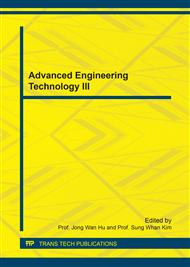p.3
p.9
p.15
p.20
p.25
p.30
p.36
p.43
p.49
Effect of Ammonia on the SiO2 Colloidal Particles Synthesized by the Stöber Method
Abstract:
Various sizes SiO2 colloidal particles in the size range of 260-950 nm were synthesized by the stöber method by adjusting the amount of ammonia from 9.0 ml to 3.0 ml while keeping 20.0 ml tetraethyl orthosilicate (TEOS), 125.0 ml ethanol, 6.0 ml ammonia and 18.0 ml distilled water fixed. In addition, X-ray diffraction (XRD) and scanning electron microscopy (SEM) were employed to analyze the crystallinity and morphology of the synthesized SiO2 colloidal particles; the XRD result show that the SiO2 colloidal particles are amorphous at room temperature; the SEM results demonstrated that the amount of ammonia could have significant effects on the size, size distribution and sphericity of the SiO2 colloidal particles. SiO2 colloidal particles were resulted with good monodispersity when the amount of ammonia was in the range of 6.0-90 ml, while SiO2 colloidal particles with double size distribution were obtained when the range is 3.0-4.5 ml; on the other hand, SiO2 spheres were resulted with good sphericity when the ammonia is in the range of 6.0-7.5 ml.
Info:
Periodical:
Pages:
25-29
Citation:
Online since:
June 2017
Authors:
Keywords:
Price:
Сopyright:
© 2017 Trans Tech Publications Ltd. All Rights Reserved
Share:
Citation:


